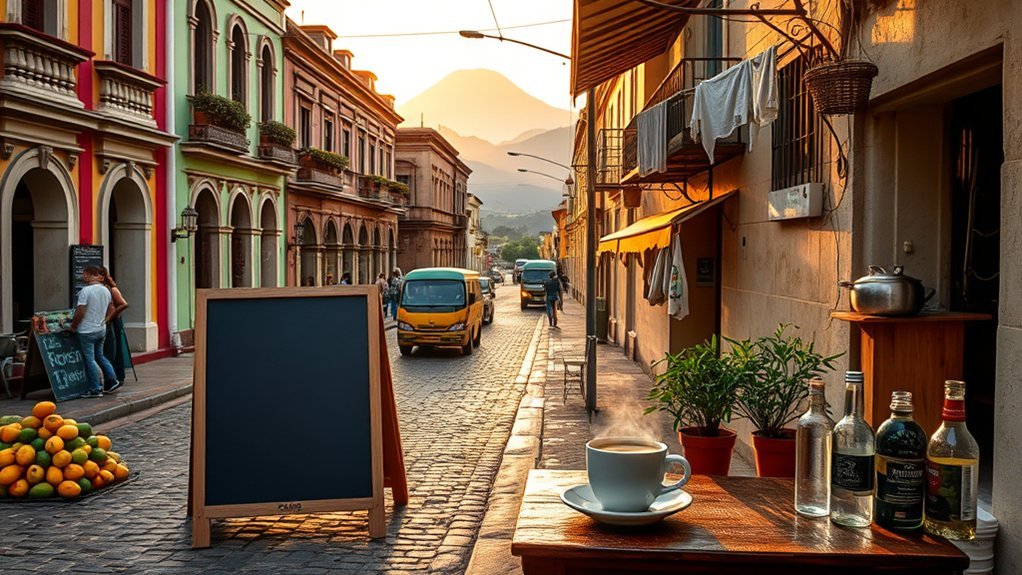You can live well in Guatemala for far less than in Europe or North America — often $500–$800 a month in smaller cities, and under $1,000 in larger ones. Rent for a private room or modest apartment runs $115–$225, food from local markets is very cheap, and buses and shared transport keep transit costs low. Basic internet and mobile plans are $15–$50 monthly, and routine healthcare is affordable. Keep going and you’ll find specific tips and numbers.
Day-to-Day Living and Daily Expenses
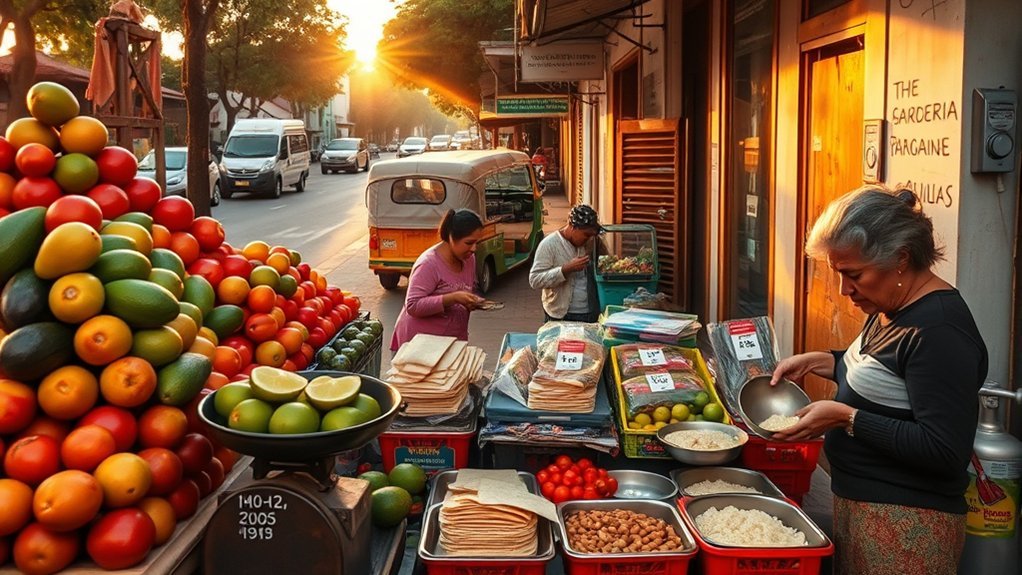
Although Guatemala’s cost of living is much lower than in Europe, you’ll find everyday essentials even cheaper than you expect: local markets sell fresh fruit at rock-bottom prices (five avocados for under $1, watermelons about $0.75), chicken-bus fares run from $0.15 for short hops to $5 for long trips, and private Spanish lessons go for roughly $3.40/hour (about $34 for five 2-hour weekly sessions).
While careful budgeting in cities like Quetzaltenango can keep monthly expenses under $500 and a private ensuite room with a double bed and utilities is available for about $115/month.
You’ll stretch your money by shopping markets, taking chicken buses for routine trips, and choosing targeted private lessons instead of pricier schools.
Expect basic groceries, street food and transport to be a fraction of European costs, so discretionary spending can cover occasional restaurants, local tours, or monthly streaming.
Track daily expenses in a simple spreadsheet, set a modest weekly food and transport limit, and you’ll find living comfortably on a tight budget is realistic in Guatemala.
Housing Options and Rent Prices
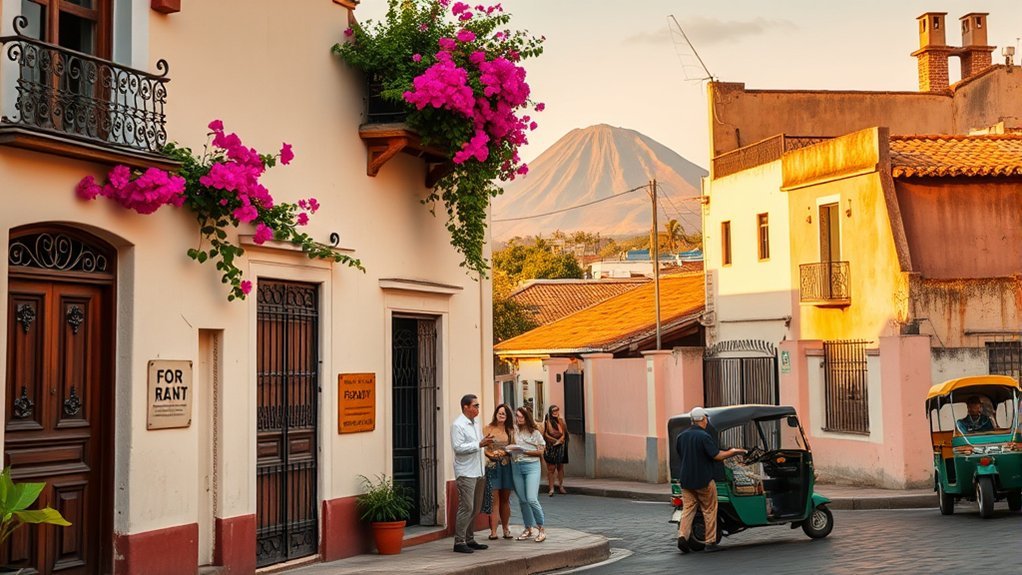
You’ll find private rooms with a double bed and ensuite for about $115/month, while private apartments cost roughly $175–$225/month if you want more independence.
Shared houses with amenities like yoga studios and communal dinners cut costs and boost social life, making them a practical option if you value community.
Compare booking directly with hosts versus platforms to secure the best rates for your needs.
Private Room Rents
One private room option that stands out is a double-bed room with an ensuite bathroom in Quetzaltenango, which runs about $115 per month all-inclusive, making it far cheaper than comparable rooms in many Western cities.
For private room rents, you’ll find practical, secure options that keep costs low while offering privacy. Private apartments typically cost $175–$225 monthly, so a $115 all-inclusive private room is a strong value if you don’t need full apartment space.
Consider these quick comparisons:
- $115: double bed + ensuite, all-inclusive, Quetzaltenango.
- $175–$225: private apartment, more space, varies by amenities.
- Western cities: often several times higher.
You’ll save markedly choosing private room rents over apartment or Western alternatives.
Shared House Options
Many shared houses in Guatemala let you rent a private room—often with a double bed and ensuite—for about $115 per month, all-inclusive, which is markedly cheaper than a private apartment at $175–$225.
You’ll save money and gain built-in social life: shared houses commonly host communal dinners for 10–25 people, so you’ll meet neighbors and learn local tips fast.
Amenities often go beyond basics—expect yoga studios with multiple weekly classes, decent Wi‑Fi, and cleaning services in some places.
If you value community and lower costs, a shared house beats solo renting; if you need privacy or quiet for work, a private apartment might justify the higher price.
Weigh cost against lifestyle when choosing.
Food, Groceries, and Local Markets
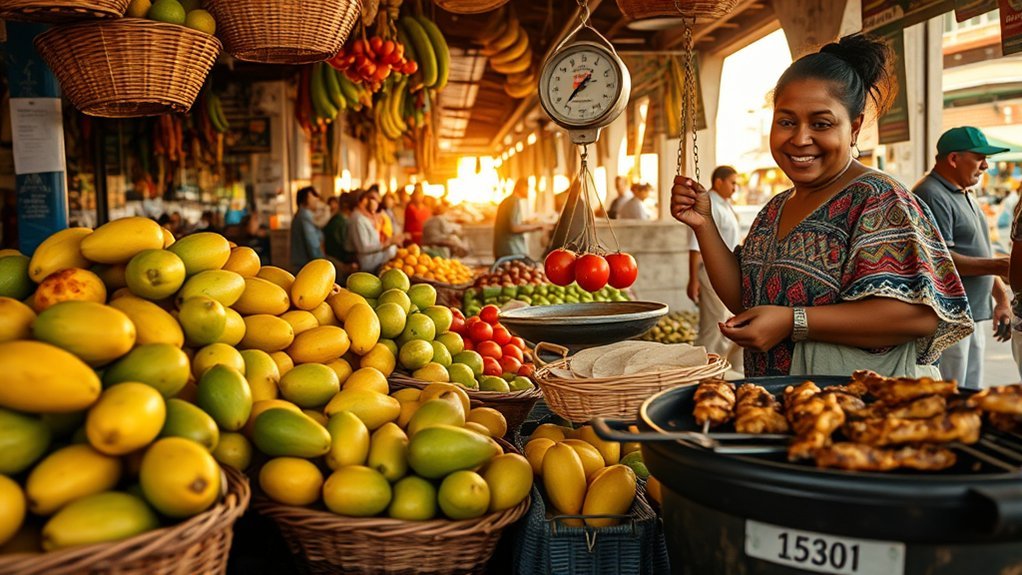
Curious how far your food budget will stretch in Guatemala? You’ll find food, groceries, and local markets make eating well cheap if you shop smart.
Fresh fruit is plentiful — think 5 avocados for under $1, 15 bananas for $1, watermelons for $0.75, papayas for $0.50 — so you can eat healthily without overspending.
Grocery stores like L Tor are convenient but pricier for imported items; budget about $20/day if you shop there often. Dining out gives options: local coffee around $3 and lunch for two from $5–$15.
- Prioritize local markets for staples and fresh produce.
- Use supermarkets selectively for imported or specialty items.
- Combine market shopping with occasional restaurant meals to stay flexible.
With careful planning and market shopping, you can keep monthly living expenses, including food, under $500 while enjoying variety and fresh ingredients.
Transportation and Getting Around
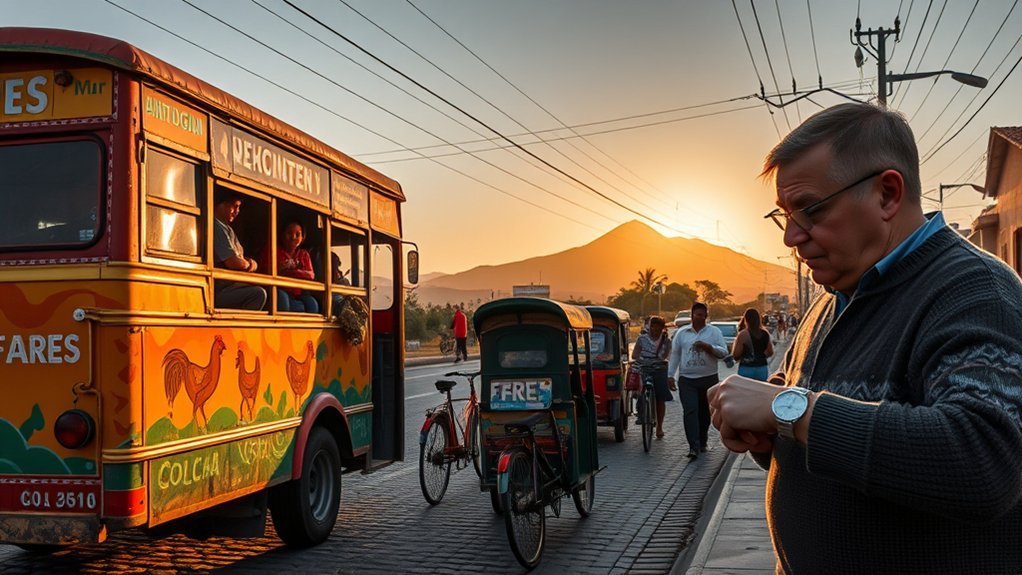
After you’ve mastered shopping local for groceries, getting around Guatemala is equally budget-friendly and straightforward. You’ll rely on chicken buses for many trips — fares run about $0.15 for very short hops, $0.50 up to $5 for longer routes — making intercity travel inexpensive compared with private car use.
Public transportation is widespread and cheap, so you can routinely move between towns without breaking the bank. If you prefer convenience, taxis and ride-sharing apps cost more than buses but remain reasonable compared with North America.
Fuel is relatively cheap too: gasoline runs about 27.99 quetzales per gallon, so driving can be affordable if you need a car. Expect average monthly transportation expenses around $115 USD, which typically covers fuel, occasional taxi rides, and mandatory car inspections if you own a vehicle.
Health Care and Insurance Costs

While Guatemala’s healthcare is far cheaper than in North America or Europe, you should still budget for monthly medical costs and reliable insurance—expect roughly $120 a month for routine expenses, with extra outlays for prescriptions or specific treatments like dengue care.
You’ll find consultations and basic procedures competitively priced, and over-the-counter meds add only modestly to your monthly spending. Still, insurance costs vary; pick a plan that covers outpatient care and emergencies to avoid surprises.
- Compare plans: prioritize coverage for hospital care, evacuation, and common tropical illnesses.
- Factor extras: routine prescriptions, specialist visits, and occasional diagnostics can push costs above the $120 baseline.
- Use local providers: clinics and private hospitals offer quality care at lower rates than North America, reducing your out-of-pocket burden.
In practice, reliable health care plus sensible insurance costs make living in Guatemala affordable and manageable for expatriates and locals.
Entertainment, Activities, and Hikes
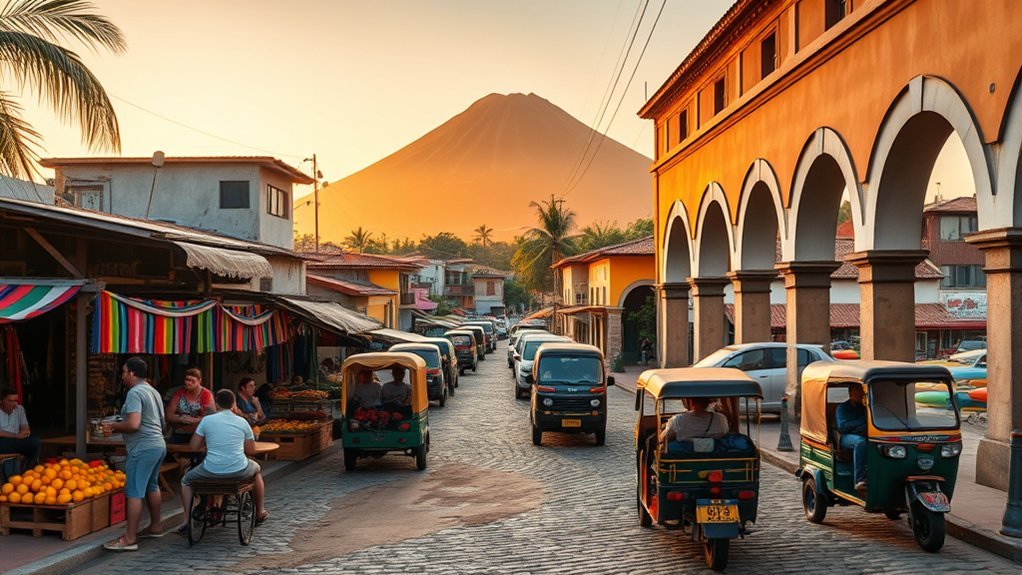
If you want affordable ways to enjoy Guatemala’s outdoors and culture, plan on roughly $150 a month for activities and prioritize a mix of low-cost local options and a few splurges like guided treks. You’ll find local coffee for about $3 and lunches from $5–$15 for two, so daily social activities stay cheap. Use chicken buses (fares ~ $0.15) to reach trailheads and towns; they keep travel costs minimal.
Compare popular treks: Acatenango as a pricier guided option (~$220 for two) versus self-guided routes like Tajumulco or Santa María that cost mainly transport and food. If you budget $150 monthly you can do regular local activities and save for occasional big hikes.
| Activity type | Typical cost |
|---|---|
| Local coffee/social | $3 |
| Lunch for two | $5–$15 |
| Bus fare (short) | $0.15 |
| Acatenango (two) | $220 |
| Local hikes | Low (transport+food) |
Utilities, Internet, and Communication
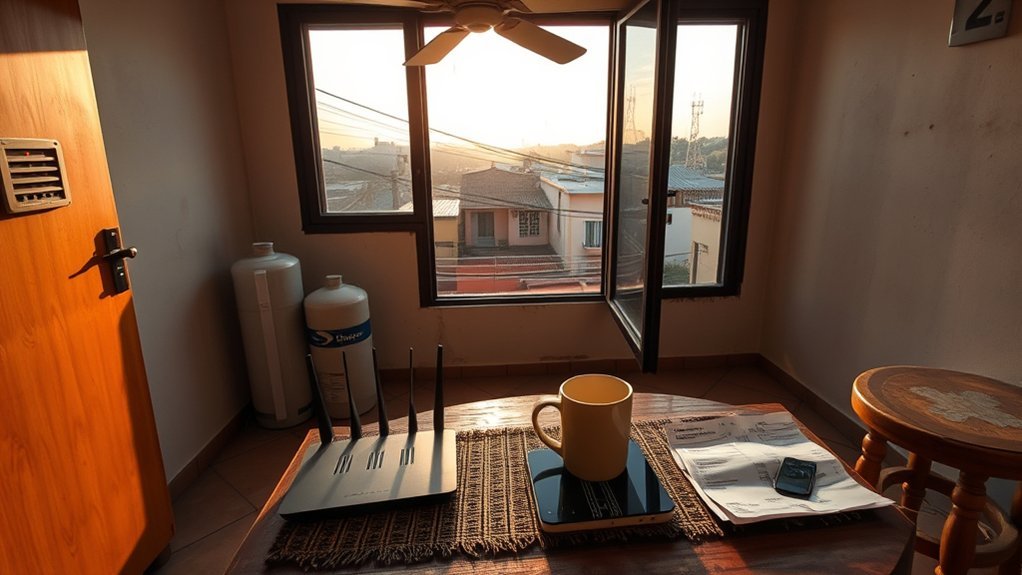
You’ll find electricity and fuel costs vary a lot between cities and rural areas, typically keeping monthly utilities in the $30–$80 range depending on use.
Internet is affordable — expect $25–$40 for decent broadband speeds — while mobile SIMs and prepaid plans can start around $10 a month.
Compare providers in your area to balance speed, coverage, and price.
Electricity and Fuel
Although Guatemala’s utility costs vary by region and lifestyle, you’ll usually find electricity, fuel, internet, and mobile services cheaper than in many North American countries.
You can expect monthly electricity bills around $30–$70 depending on usage and household size. Fuel (gasoline) runs about 27.99 Cales per gallon, often below prices in Mexico or Canada, so driving is relatively affordable.
Compare and plan:
- Budget $30–$70 monthly for electricity for typical households.
- Factor fuel costs at ~27.99 Cales/gal if you drive regularly.
- Add $10–$30 for basic-to-unlimited mobile service; internet and water may add $25–$50 and $0–$20 respectively.
You’ll save versus many North American locales, especially if you moderate power use and choose prepaid mobile plans.
Internet Speed & Cost
While urban areas like Antigua and Guatemala City generally offer faster, more reliable connections, internet service across Guatemala ranges from basic 10 Mbps plans to 100 Mbps packages costing roughly $30–$50 per month, with mobile data options around $15–$30 monthly.
You’ll find better internet speed and cost choices in cities; rural areas often have fewer providers and slower connections.
Compare plans by advertised Mbps versus real-world reports—users note slower speeds during peak times and occasional outages. If you work remotely or stream, prioritize higher-tier plans and ask neighbors or expat groups about reliability.
For light browsing, a lower-cost 10–25 Mbps plan usually suffices. Always confirm contract terms, installation fees, and whether promotional pricing will increase after the initial period.
Mobile Plans & SIMS
If reliable internet at home can be spotty or expensive, mobile plans are often your best backup for connectivity. You’ll find plans typically cost $15–$30/month, good for light to heavy users, while prepaid SIM cards start around $5 with initial credit.
Major providers like Tigo and Claro offer the widest coverage and competitive pricing, so you’ll compare signal maps before committing. Urban areas have lots of Wi‑Fi, but mobile data’s essential in rural zones or when you travel.
- Choose prepaid for short stays or low commitment.
- Pick monthly plans if you need consistent high-speed (often up to 10GB).
- Prioritize providers with unlimited social media bundles for savings.
Cost of Learning Spanish and Education
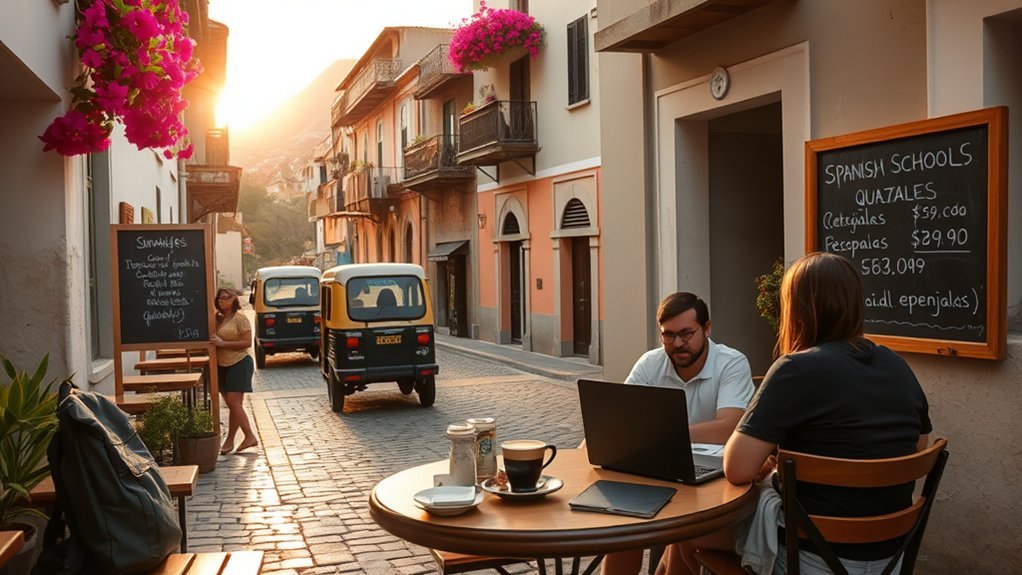
Because private Spanish lessons in Guatemala run about $3.40 an hour—roughly half the cost of language-school classes at about $7—you can get more personalized instruction for less, especially if you book the common schedule of five 2-hour lessons a week (around $34).
Private Spanish lessons in Guatemala cost about $3.40/hour—half the price of school classes—offering affordable, personalized instruction.
The cost of learning Spanish here is pragmatic: private tutors stretch your budget and tailor lessons to your goals, while schools offer structure and social practice at higher rates.
You’ll accelerate learning by combining lessons with real-life practice. Local markets provide inexpensive, high-value conversation drills with vendors, and daily interactions immerse you in vocabulary and pronunciation you won’t get from textbooks.
If you’re balancing time and money, prioritize regular private sessions plus market practice for rapid progress. For families or longer programs, compare weekly private costs to school packages to decide if group classes’ structure justifies the premium.
Ultimately, Guatemala gives you flexible, affordable education options that reward immersive effort.
Tips for Living Cheaply in Guatemala
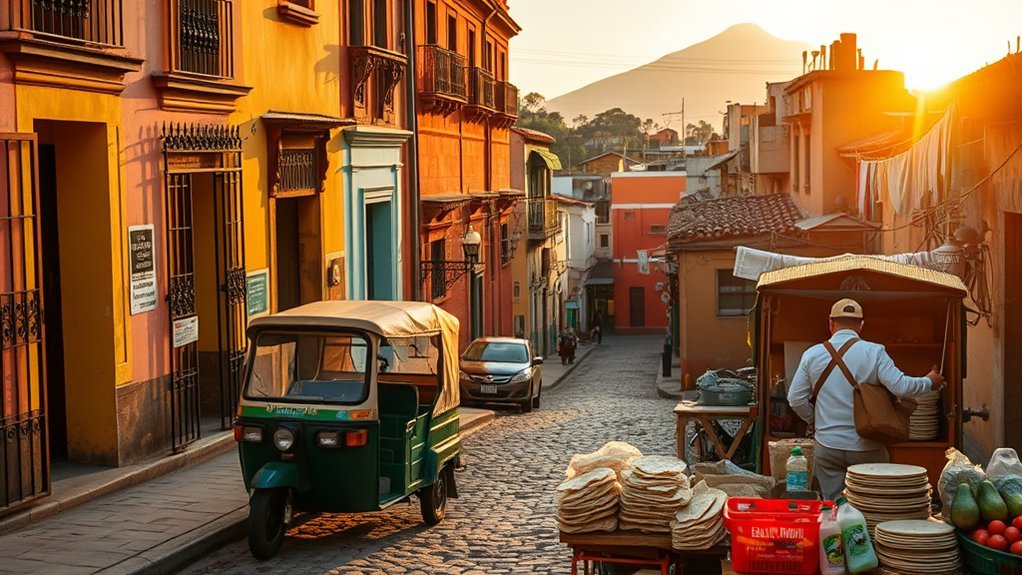
When you prioritize local markets, shared housing, and low-cost transport, you can cut living expenses dramatically in Guatemala. You’ll find the Cost of Living drops fast when you buy fresh fruits at mercados—5 avocados for under $1 or 15 bananas for $1—and cook at home.
Private rooms in shared houses can be as low as $115/month, so compare neighborhoods and amenities to balance safety and price. Spanish lessons at about $3.40/hour are cheaper than online alternatives and speed up integration.
- Use chicken buses and local collectivos (15¢–$5) instead of taxis to save daily transit costs.
- Share housing and utilities to cut rent and bills roughly in half.
- Buy produce at markets and join community dinners to lower grocery and dining expenses.
Actively compare options, negotiate when appropriate, and prioritize local resources; small daily choices add up and materially reduce your Cost of Living.
Frequently Asked Questions
Is $100 Dollars a Lot in Guatemala?
Yes — you’ll find $100 offers strong cost value in Guatemala; it won’t cover everything, but it’s meaningful for rent contributions, several days of groceries, many Spanish lessons, or multiple local meals if you budget wisely.
Can a US Citizen Live in Guatemala?
Yes — you can live in Guatemala: tourist visa covers up to 180 days annually, or you can pursue temporary residency. Compare visa options, prove finances or ties, register if staying long-term, and get health insurance.
Is Guatemala a Good Place to Live?
Yes — you’ll find Guatemala rewarding: it’s affordable, offers a rich Cultural Experience, and feels more vibrant than many places. You’ll enjoy low living costs, friendly communities, varied outdoor activities, and practical, immersive day-to-day life.
How Much Is Rent in Guatemala per Month?
Budget-friendly beats: you’ll typically pay $115 for a private room, $175–$225 for a private apartment, or about $919 average monthly; Rental Prices vary, so compare locations, shared options, and short-term stays for practical savings.
Conclusion
Living in Guatemala will often cost you far less than in the U.S. or Europe, but your lifestyle swings the budget. You’ll pay a fraction for rent, food, transport, and activities, though private healthcare and expat comforts raise prices. If you stick to local markets, shared housing, and public buses, you’ll stretch your money like elastic. Practical choices and basic insurance keep you comfortable without overspending—choose what matters and compromise on the rest.

